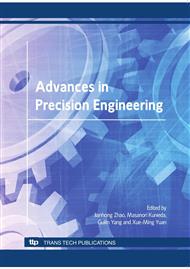p.619
p.624
p.634
p.639
p.643
p.648
p.652
p.657
p.661
Electrical Conductivity and Flexural Strength of Graphite/Carbon Nanotubes/Epoxy Nanocomposites
Abstract:
Carbon nanotubes (CNTs) have excellent mechanical and electrical properties. CNTs reported have excellent properties that can replace conventional conductive filler in advanced engineering applications. The polymer matrix was epoxy resin (EP).Conductive fillers were MWCNTs and synthetic graphite (G). Different variation of CNTs (0~10 wt. %) and graphite (60 ~ 67.5 wt. %) loading concentration were added into the epoxy resin. Dispersion of CNTs and G in epoxy resin were conducted by internal mixer with a Haake torque rheometer. The mixture of G/CNTs/EP was poured into the steel mold, and G/CNTs/EP nanocomposites had been fabricated through compression molding. The electrical conductivity of nanocomposites in term of variation of G and CNTs concentration were measured by the four point probe for in plane electrical conductivity. The results revealed that addition of G/CNTs and increasing curing temperature are an effective ways to produce high electrical conductive nanocomposites. Dispersion quality of CNTs and G in epoxy matrix were observed on the fractured surface by scanning electron microscopic.
Info:
Periodical:
Pages:
643-647
Citation:
Online since:
September 2010
Authors:
Keywords:
Price:
Сopyright:
© 2010 Trans Tech Publications Ltd. All Rights Reserved
Share:
Citation:


